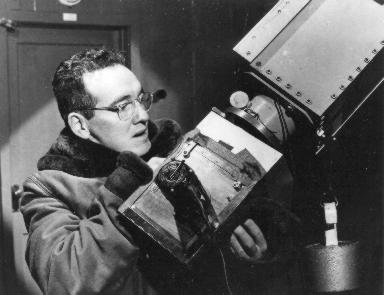

Walter Orr Roberts is shown taking photos of the solar corona with the 5 inch coronagraph he built with the assistance of Hobart P. French and his Harvard Ph.D. advisor Donald Howard Menzel. This, only the third coronagraph in the world and the first in the western hemisphere, was made possible by Don Menzel's entrepreneurial skills and Walt's technical capabilities. Walt and his wife began their six-year residency at "The Fremont Pass Station of the Harvard College Observatory" on August 15, 1940. It was here that Walter Orr Roberts discovered the link between solar flares and radio interference, and during World War II the military used the information he gathered to ensure uninterrupted communications.
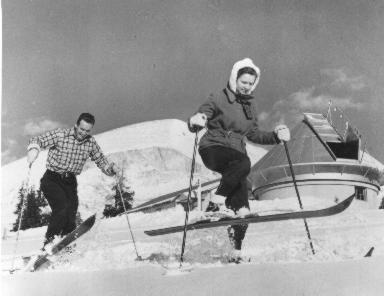
This photo, ca. 1945, shows Walt Roberts and his wife Janet Smock Roberts in front of the original Climax installation below Bartlett Mountain (background). This is one of several photos that Life Magazine photographer George Leavens took to illustrate a November 17, 1945 Life article entitled "The Coronagraph". The impact of the Climax Molybdenum Company's mining operation can be clearly seen on the flank of Bartlett Mountain.
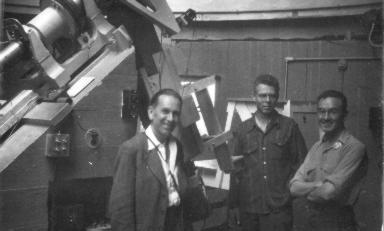
Bernard Lyot (left), the inventor of the coronagraph, visits the HAO installation on Fremont Pass during July 1946. Earlier that year, the efforts were formally incorporated in "The High Altitude Observatory of Harvard College and the University of Colorado." HAO's first two employees were John (Jack) Wainwright Evans Jr. (center) and Walt Roberts (right).
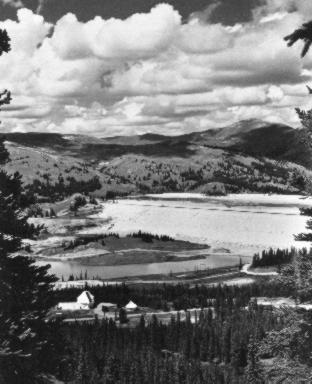
This view of the observing station is looking north from Chalk Mountain. The larger dome housed a 16 inch coronagraph and its associated spectrograph and magnetograph. The smaller dome contained the older 5 inch coronagraph and the H-alpha flare patrol telescope which operated constantly during clear daylight hours. In 1952, the observatory facilities were moved 5 miles to the west from the original site to avoid the impact of airborne particulate matter produced by the neighboring mining operations at Climax Molybdenum Company.
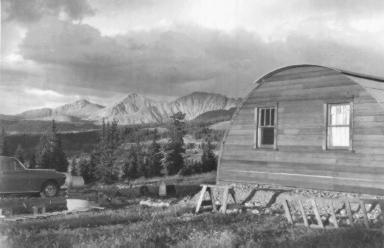
As operations expanded at the new site, housing facilities such as the one pictured above were needed.
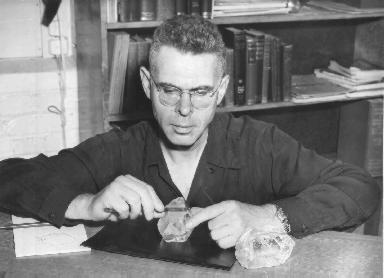
Jack Evans makes preliminary measurements on two large quartz crystals in order to construct a quartz monochromator. Quartz slabs cut from these crystals were layered and spaced to create a "birefringent filter". Bernard Lyot had pointed out how such a filter could operate, but it was Evans who perfected the construction process. The birefringent filters are capable of transmitting very narrow wavelength (~5 angstroms at a time in any part of the spectrum) bands of electromagnetic radiation.
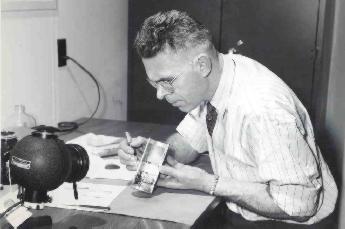
In this photo, Jack Evans works on the assembly of a birefringent filter.
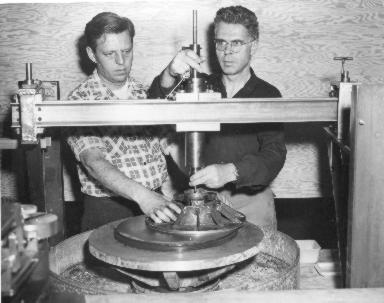
The delicate job of grinding a 16 inch lens for an "inside-out" telescope or coronagraph is under way in the Boulder optical shop of HAO. Pictured adjusting the grinding mechanism are Frederick B. Pearson (left) chief optician for the observatory, and Dr. John W. Evans, noted optical physicist and member of the observatory staff. Two 26 foot coronagraphs, the world's largest, were then under construction by the Westinghouse Electric Corporation at Sunnyvale, California. The instruments were used for solar research programs conducted by HAO, which at that time was affiliated with Harvard University, Harvard College Observatory, and the University of Colorado.
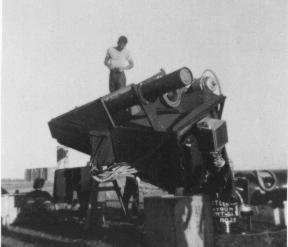
1952 eclipse expedition to Khartoum, Sudan.
In collaboration with the Naval Research Laboratory, HAO observed the 25 February 1952 eclipse in Khartoum with a spectrograph. A large number of spectrograms were obtained by the eclipse team of Jack Evans, Robert Cooper, and Robert Lee.This remarkable eclipse experiment -- the most advanced of its kind at that time -- studied the spectrum of elements present in the solar chromosphere with unprecedented height discrimination and high spectral resolution. The spectra provided the first experimental evidence for the newly developed concept of non-local thermodynamic equilibrium conditions in the solar atmosphere. Results from the experiment formed the basis for numerous publications at HAO and elsewhere in the 1953 - 1960 period and, in fact, provided the impetus for HAO to develop into a broad, research-oriented institution.
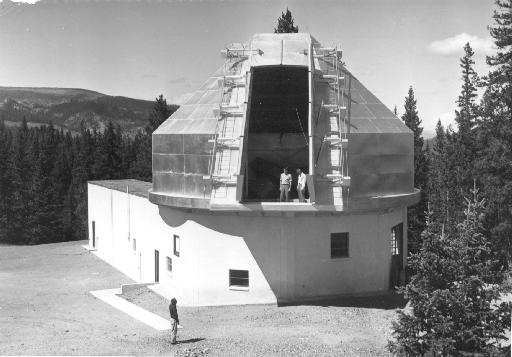
The large observing dome at Chalk Mountain was completed in 1954 and housed the 26 foot spar. This photo from 1956/7 shows the Climax observing team of Keith Watson, Dave Dodgen and Dick Hansen.
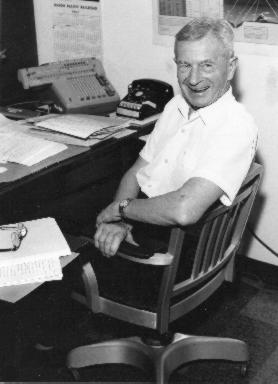
Sydney Chapman, distinguished author of hundreds of research works on the upper atmosphere, earth magnetism, the aurora, and the solar corona, had a great influence on the course of HAO's research. Beginning in 1957, Chapman returned to HAO each summer as a visiting scientist. He spent his winters at the University of Alaska's Geophysical Institute at Fairbanks. He also served as international president of the International Geophysical Year.
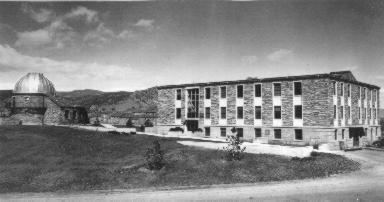
In 1946, the Climax station underwent its first major change: it became the High Altitude Observatory, a joint endeavor of the University of Colorado (CU) and Harvard University, with Roberts as its Director. HAO's laboratories were relocated to the CU campus. In 1948, HAO and CU cooperated to establish the Summers-Bausch Observatory (seen on left side of photo). During the last half of the 1950s, HAO scientists pooled their talents with CU's faculty to form the University's Department of Astro-Geophysics. The Astro-Geophysics building (seen on right side of the photo) was dedicated October 8, 1960.
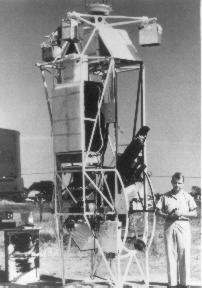
Gordon Newkirk Jr. Coronascope-I Balloon Experiment 1960.
Extended observation of the intermediate corona was the ultimate purpose of balloon experiments such as the one pictured. This project used an unmanned stratospheric balloon to raise a coronagraph above the dust and smoke of the lower atmosphere for several hours of continuous operation. At the end of the day's observation, the instrument and its photographs were returned to the ground by parachute. The gondola holding the instrumentation was the same one used by Princeton physicist Martin Schwarzschild to take images of the solar granulation with his "stratoscope" in 1959. The first two successful deployments of Coronascope-I were made outside of Minneapolis, in cooperation with the General Mills Company, in September and October of 1960.
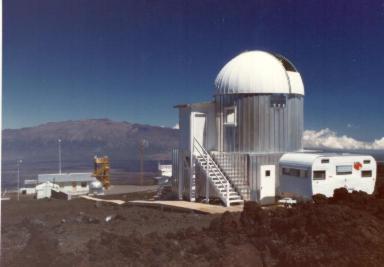
HAO's Mauna Loa Solar Observatory.
HAO established the Mauna Loa Solar Observatory in 1965, and over time instruments from the Climax site were moved here to take advantage of the superior seeing conditions.
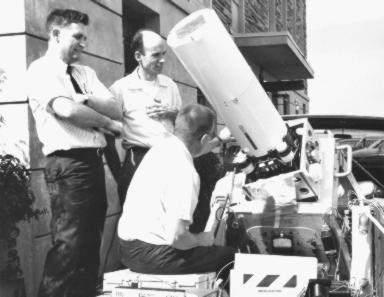
Preparations for the 1966 eclipse.
Jack Eddy, John Firor, and Bob Lee prepare the eclipse expedition coronagraph at the HAO Astro-Geophysics Department building on the University of Colorado campus. Two different HAO teams were involved in this eclipse. A coronal camera designed by Gordon Newkirk Jr. made its debut with photometric and polarimetric observations from a site near Pulacayo, Bolivia. Near-infrared iron line observations were conducted with a new instrument carried by a NASA aircraft based at Porto Alegre, Brazil.
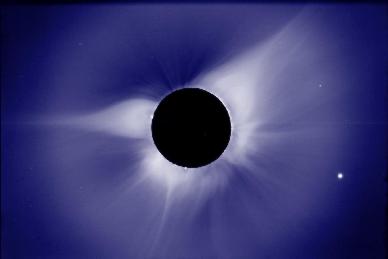
Coronal photograph from HAO's 1966 eclipse expedition.
The solar corona observed about two seconds after second contact during the eclipse of 12 November 1966 at Pulacayo, Bolivia (altitude 13,000 ft). This photograph, made with a radially symmetric, neutral density filter in the focal plane to compensate for the steep incline of coronal radiance with increasing distance, allows structural features to be traced from the chromosphere out to 4.5 RO. The overexposed image of Venus appears in the SW quadrant. Typical helmet streamers overlie prominences at the NE and NW limbs while another streamer at high latitude in the SE develops into a narrow ray at large distance. Arches in the corona and the absence of coronal material in domes immediately above prominences are particularly striking at the bases of the NW limb at a latitude of about 25°.
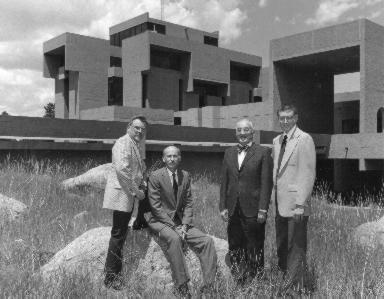
First four HAO Directors, with NCAR Mesa Lab in the background.
Left to right: Gordon Newkirk Jr., John Firor, Walter Orr Roberts, and Robert MacQueen.
-Captions provided by Tom Bogdan.